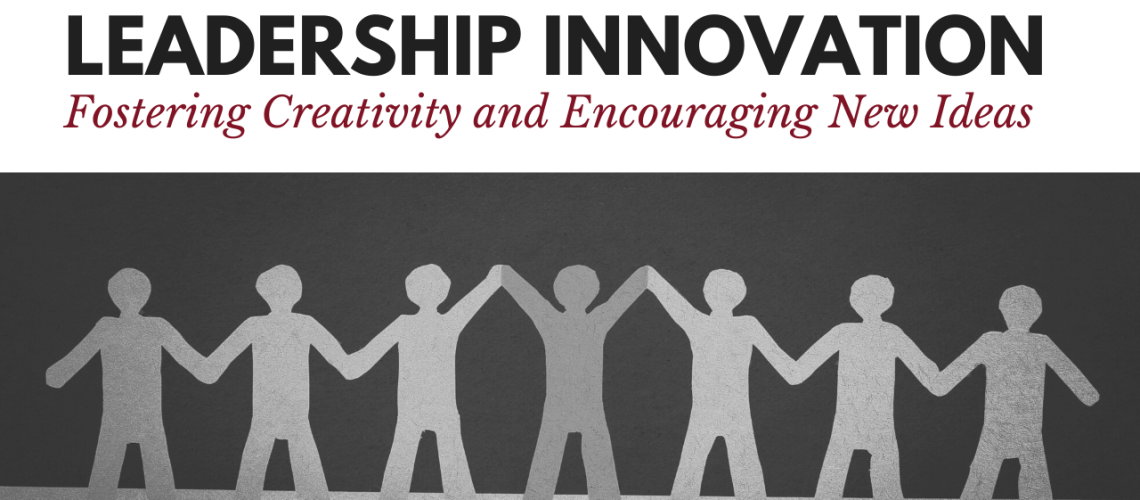By Dr. Salam Slim Saad
Business is changing. In today’s competitive marketplace businesses are under constant pressure to be more innovative and creative in order to survive and thrive.
The way leaders foster innovation and creativity can greatly affect an organization’s performance. Organizations that encourage interesting ideas from the top ranks of management can become more innovative and successful than others.
A good leader is expected to be knowledgeable, enthusiastic and always innovative. But fostering creativity and innovation is not as simple as it sounds.
It has been said, “Creativity is giving new meaning to old things,” and that’s what we are looking to do — give new meaning to old things. This article addresses a real problem with the way people lead today and offers a fresh, better approach that will foster innovation and creativity, as well as sustainability — in short create leaders of the future.
Challenges and Barriers to Creativity and Innovation
While fostering creativity and innovation is crucial for organizational growth, leaders often face various challenges and barriers that can impede these efforts. It’s essential to recognize and address these obstacles to create an environment where innovation can thrive. Here are some common challenges and barriers to consider:
- Resistance to Change: Employees and even leaders themselves may resist departing from familiar routines and established processes, making it difficult to introduce new ideas and approaches.
- Fear of Failure: The prospect of failure can deter individuals from taking risks and exploring innovative solutions, stifling creativity and experimentation.
- Lack of Resources: Limited budget, time constraints, or insufficient access to necessary tools and technologies can hinder the development and implementation of innovative ideas.
- Inflexible Organizational Culture: An organizational culture that does not encourage risk-taking, experimentation, and open dialogue can suppress creative thinking among employees.
- Hierarchical Structures: Traditional hierarchical structures can inhibit idea-sharing and collaboration by restricting input from employees at lower levels.
- Groupthink and Conformity: The pressure to conform to existing norms and opinions within a group can discourage individuals from expressing unique ideas and perspectives.
- Lack of Support from Leadership: When leaders do not prioritize or actively support creative initiatives, employees may be hesitant to invest time and effort in generating innovative ideas.
- Unclear Goals and Direction: Without clear goals and a well-defined innovation strategy, employees may lack direction and purpose in their creative endeavors.
- Short-Term Focus: Focusing solely on short-term results and immediate goals can hinder the exploration of more far-reaching, innovative concepts.
- Resistance to Unproven Concepts: A bias toward only embracing ideas that have a proven track record can limit the exploration of novel, untested concepts.
- Lack of Diversity and Inclusion: A lack of diversity in the workforce can limit the variety of perspectives and ideas, leading to a narrower range of creative solutions.
- Communication Barriers: Ineffective communication channels and poor information-sharing can hinder the flow of ideas and collaboration among team members.
- Overemphasis on Efficiency: A strong emphasis on efficiency and optimization can discourage employees from taking time to explore new ideas and innovative approaches.
- External Market Pressures: Pressure to meet market demands and quick turnarounds may limit the time available for exploring innovative solutions.
Overcoming Challenges and Barriers
While fostering creativity and innovation in the workplace is immensely rewarding, it’s important to acknowledge and address the challenges and barriers that can arise. By proactively tackling these obstacles, you can create an environment that empowers your team to overcome hurdles and unleash their creative potential. Here’s how to navigate through common challenges:
Encourage a Growth Mindset
Challenge: Employees may be hesitant to step out of their comfort zones due to a fixed mindset that fears failure.
Solution: Promote a growth mindset that embraces challenges and views setbacks as opportunities for learning and growth. Encourage employees to see failure as a steppingstone toward improvement.
Manage Time and Resources
Challenge: Limited time and resources can hinder the pursuit of creative projects.
Solution: Provide dedicated time and resources for creative endeavors. Set clear priorities and allocate resources effectively to ensure that creativity doesn’t get overshadowed by day-to-day tasks.
Address Resistance to Change
Challenge: Resistance to change can stall the adoption of new ideas and innovative practices.
Solution: Communicate the benefits of innovation clearly and transparently. Address concerns and misconceptions and highlight success stories to showcase the positive impact of change.
Foster Inclusive Participation
Challenge: Some team members may feel excluded from creative processes.
Solution: Encourage participation from diverse voices and backgrounds. Create inclusive environments where everyone feels valued and empowered to contribute their unique perspectives.
Create Psychological Safety
Challenge: Fear of judgment can stifle creative expression and risk-taking.
Solution: Foster an environment of psychological safety where individuals feel comfortable sharing unconventional ideas. Encourage open dialogue, constructive feedback, and nonjudgmental discussions.
Overcome Bureaucratic Hurdles
Challenge: Bureaucratic processes can slow down the implementation of innovative ideas.
Solution: Streamline approval processes for innovative projects. Empower teams to make decisions quickly and provide guidance on navigating organizational structures.
Recognize and Reward Innovation
Challenge: Lack of recognition and rewards can demotivate employees from pursuing creative endeavors.
Solution: Establish recognition programs that celebrate and reward innovative contributions. Showcase successful projects and publicly acknowledge the efforts of creative individuals and teams.
Align with Organizational Goals
Challenge: Innovative ideas might not align with the organization’s strategic objectives.
Solution: Clearly communicate the link between creative initiatives and the organization’s goals. Encourage teams to align their innovative efforts with broader objectives.
Overcome Fear of Failure
Challenge: The fear of failure can deter employees from taking risks and trying new approaches.
Solution: Normalize failure as a natural part of the creative process. Share stories of successful innovations that emerged from initial failures to inspire a more fearless approach.
Provide Training and Development
Challenge: Employees may lack the necessary skills or knowledge to execute innovative ideas.
Solution: Offer training and development opportunities to enhance employees’ creative skill sets. Provide resources for learning new techniques and tools that support innovative thinking.
Exemplary Leaders Driving Innovation
In the land of leadership, there are a select few individuals whose visionary approaches and unwavering commitment to innovation have left an indelible mark on their respective industries. These leaders have not only shaped the course of their companies but have also redefined the boundaries of what is possible through their groundbreaking ideas and willingness to challenge conventions. Let’s explore the stories of some of these remarkable leaders and the innovative cultures they’ve fostered:
A. Steve Jobs and Apple’s Transformative Products
Steve Jobs, the co-founder of Apple Inc., is identical with innovation. His ability to anticipate consumer needs and translate them into revolutionary products redefined industries and set new standards for design and functionality. From the introduction of the iPod, which transformed the music industry, to the iPhone, which revolutionized how we communicate and interact, Jobs consistently demonstrated a keen understanding of user experience and a relentless pursuit of excellence.
Jobs’ innovation philosophy was deeply rooted in simplicity and elegance. He famously stated, “Design is not just what it looks like and feels like. Design is how it works.” This emphasis on user-centric design led to products that seamlessly incorporated technology into people’s lives. His inflexible commitment to innovation, combined with an insistence on pushing the boundaries of possibility, has tiled Apple’s reputation as a company that continually reshapes industries and changes the way we live.
B. Elon Musk’s Disruptive Approach to Industries
Elon Musk, the CEO of SpaceX, Tesla, and X is a modern-day visionary known for his audacious goals and disruptive innovations. Musk’s approach to leadership is characterized by his willingness to take on complex challenges that others deemed insurmountable. From electric vehicles to space travel, his ventures have challenged traditional industries and norms, often resulting in groundbreaking advancements.
At SpaceX, Musk aimed to make space travel more affordable and accessible by developing reusable rockets—a feat previously thought to be unachievable. His determination and innovative thinking led to the successful landing and reuse of rocket stages, drastically reducing the cost of launching payloads into space. Similarly, at Tesla, Musk’s focus on sustainable transportation and the mass adoption of electric vehicles has redefined the automotive industry’s direction.
C. Indra Nooyi’s Innovation-Driven Culture at PepsiCo
Indra Nooyi, the former CEO of PepsiCo, is an initiator known for her visionary leadership and commitment to fostering innovation within her organization. Under her guidance, PepsiCo shifted its focus toward healthier products and sustainability, reflecting changing consumer preferences and global challenges. Nooyi’s leadership was marked by a genuine commitment to making a positive impact on society while driving business growth.
Nooyi recognized the importance of embedding innovation into PepsiCo’s culture. She encouraged cross-functional collaboration, inviting employees from different departments to contribute their unique perspectives and ideas. One of her notable initiatives was the “Performance with Purpose” strategy, which aimed to deliver sustainable growth while addressing social and environmental concerns. Through innovative product offerings, such as healthier snacks and beverages, PepsiCo under Nooyi’s leadership demonstrated that innovation can be aligned with corporate responsibility and long-term success.
In addition to these exemplary leaders, several innovative companies have also set the standard for fostering creativity and new ideas within their organizations:
- Google: Google is renowned for its innovative and creative culture. The firm encourages its staff to dedicate 20% of their time to initiatives supporting the company’s objectives. Several successful products, like Gmail and Google News, have resulted from this “20% time” philosophy.
- Apple: The iPhone and iPad are just two of the company’s cutting-edge devices. In the company’s approach to innovation, user experience, design, and simplicity are prioritized. Apple also promotes a culture of confidentiality, enabling staff to concentrate on new ideas without worrying about pressure or criticism from outside sources.
- Amazon: Amazon has an innovative culture led by its founder and CEO, Jeff Bezos. The business promotes bold ideas, taking chances, and a “fail fast” innovation strategy that enables speedy testing and learning from failure. Amazon’s leadership values foster creativity, prioritizing customer obsession, ownership, and innovation.
Final Thought
“Innovation is the calling card of the future.” – Anna Eshoo
In today’s rapidly evolving business landscape, the importance of innovation cannot be overstated. As organizations grapple with a multitude of challenges and barriers to creativity, it becomes clear that leaders must play a pivotal role in driving innovation.
In the world of exemplary leaders, visionaries have demonstrated that innovation is not a mere buzzword but a guiding principle that can transform industries and societies. Their relentless pursuit of innovation has set them apart as pioneers who challenge conventions and redefine possibilities.
Furthermore, companies have established innovative cultures that prioritize creative thinking and risk-taking, leading to groundbreaking products and services that shape our daily lives.
In this era of change and uncertainty, the quote by Anna Eshoo reminds us that innovation is not a choice but a necessity for shaping a brighter future. As leaders and organizations continue to embrace innovation, they pave the way for progress, growth, and lasting impact.



